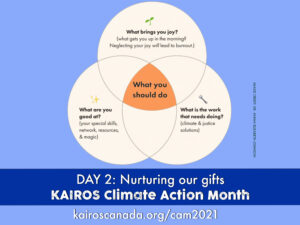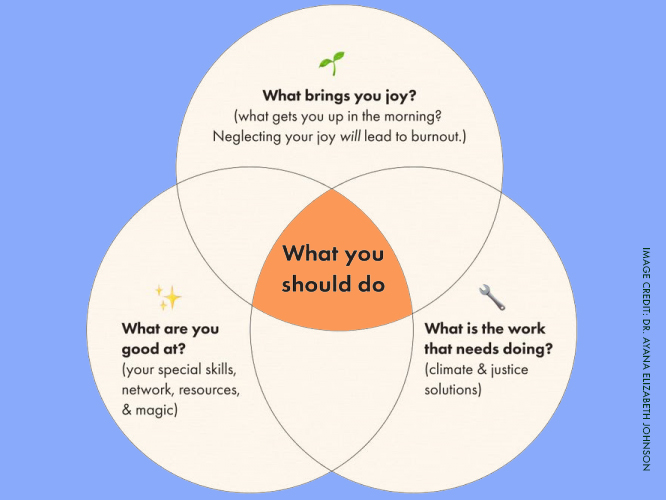Nurturing our gifts for climate action #KAIROSClimateAction

There is no shortage of work to be done to address the climate crisis and when considering the multitude of things that need to happen, it is easy to feel overwhelmed and ask yourself, “What can I do?” or “Where do I even start?”
We know that actions by government, industry, and other large emitters will have the most impacts in reducing greenhouse gas emissions and in building a new low-carbon economy. However, individual and household-level actions also play a significant role in this time of transformation. Individual actions signal to leaders and the market that we are ready for transformation and will favour political leaders and economic activity that align with our priorities. When we talk about these actions and share them with others, we are also working to change the hearts and minds of friends and family.
A helpful exercise developed by Dr. Ayanna Elizabeth Johnson can help you answer the question “What can I do?” and discern your own personal gifts for climate action. Dr. Johnson is a marine biologist, policy expert, writer, and host of the podcast How to Save a Planet. She used a Venn diagram in her own life to see where there was overlap in her talents and interests and the problems she wanted to help solve. Each of us has specific talents, aptitudes, and interests that will reveal how we can best contribute to the climate movement.
We encourage you to try this exercise out today. Draw three intersecting circles on a piece of paper and write your answer to each of the three questions below in each circle
- What are you good at?
- What is the work that needs doing? Or What is the solution you want to work toward?
- What brings you joy?
When thinking about what you are good at, consider all the things that you can create, arrange, write, host, develop, bake, perform, etc. Consider all your skills as well as connections and resources you have access to.
If you are not as familiar with “the work that needs doing” or the “solution you want to work toward” – don’t worry. We encourage you to check out Project Drawdown, which conducts ongoing review and analysis of climate solutions. The website keeps an extensive list of solutions and their corresponding impact on reducing greenhouse gas emissions.
The element of joy is important as it will help to sustain your action. Without this motivation and joy, we are much more susceptible to burnout. Also, if we are joyful about our work, we are likely to motivate others and draw more people in to join us.
As you complete the three circles, some ideas where your lists overlap will begin to emerge and reveal what it is you should do to address climate change. This is called your “individual impact starting point”. This small exercise lets us see where we fit in the greater climate movement – what will allow us to make a meaningful contribution without feeling helpless and while taking care of our souls, so we limit burnout.
Discerning our gifts requires time for reflection so we encourage you to set aside some time this week to complete the exercise. We invite you to share your Venn diagram with others social media using #KAIROSClimateAction.









